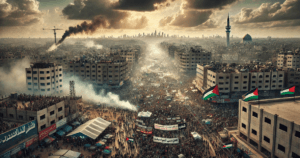Mass Protests Rock Gaza: Thousands Demand Hamas Step Down Amid 18-Month War
Thousands of Palestinians have staged rare protests across Gaza, demanding that Hamas relinquish power and end the devastating 18-month war with Israel. The demonstrations began in Beit Lahiya before spreading to Gaza City and central areas, driven by widespread suffering and frustration. While past protests urged Hamas to reconcile with rival Fatah, this marks the first time people have openly called for the group to step aside. The protests have remained largely peaceful, with Hamas’s security forces staying out of sight, though the group warns that Israel may exploit the unrest to create internal divisions.
Israeli Prime Minister Benjamin Netanyahu sees the demonstrations as proof that Hamas is losing its grip on Gaza, urging more Gazans to take to the streets. The conflict began in October 2023 when Hamas attacked Israel, killing 1,200 and taking 250 hostages, prompting a prolonged Israeli military response. Since the ceasefire collapsed on March 18, Israeli airstrikes have killed over 830 people, raising the total death toll in Gaza to more than 50,000. With ceasefire negotiations stalled, Israel is preparing further military operations while civilians brace for more devastation.

Mass Protests Rock Gaza: Thousands Demand Hamas Step Down Amid 18-Month War
This week, thousands of Palestinians in Gaza staged rare public demonstrations against Hamas, the militant group that has ruled the territory since 2007. The protests began Tuesday in Beit Lahiya, a town in northern Gaza, and quickly spread to Gaza City and other central areas by Wednesday. For days, crowds have demanded that Hamas step down from power and end the 18-month war with Israel, which has devastated the region and claimed tens of thousands of lives.
The protests, described by participants as spontaneous, reflect growing frustration over severe hardships. Rezeq Salem, a protester, said people are fed up with the “unbearable” conditions caused by the war, including shortages of food, medicine, and basic services. While small protests against Hamas have occurred in the past—often calling for unity with the rival Fatah party, which controls parts of the West Bank—this marks the first time Gazans have openly demanded that Hamas relinquish power and sustained demonstrations over multiple days.
So far, the protests have remained largely peaceful, and Hamas security forces have not intervened publicly. However, Hamas leaders and allies have dismissed the demonstrations, arguing that efforts should focus on ending the war and pressuring Israel to allow more humanitarian aid into Gaza. They have also accused Israel of exploiting the unrest to sow division among Palestinians.
Israel Sees Opportunity in Unrest
Israeli Prime Minister Benjamin Netanyahu has pointed to the protests as evidence that Hamas is losing public support. Addressing Israel’s parliament, he stated, “This is the first time we’re seeing mass protests against Hamas. The people of Gaza are realizing the destruction Hamas has brought upon them.” Defense Minister Israel Katz echoed this view, urging more Gazans to join the demonstrations to pressure Hamas.
The conflict began in October 2023 when Hamas militants launched a surprise attack on southern Israel, killing 1,200 people and taking 250 hostages. Israel responded with a large-scale military campaign in Gaza, pledging to continue until Hamas surrenders and the remaining 59 hostages are released.
A temporary ceasefire earlier this year briefly paused the fighting, but hostilities resumed on March 18. Since then, Israeli airstrikes have killed over 830 people in Gaza, according to the Hamas-run health ministry, raising the total death toll to more than 50,000. The ministry does not distinguish between civilian and combatant deaths, making it difficult to assess precise figures.
Humanitarian Crisis Deepens as War Drags On
The war has left Gaza in ruins, with widespread destruction of homes, hospitals, and infrastructure. Over 80% of the population has been displaced, and aid groups warn of famine-like conditions due to blocked supply routes. Israel has restricted the flow of food, fuel, and medical supplies into Gaza, citing security concerns, though international pressure has led to occasional aid shipments.
Despite global calls for peace, ceasefire negotiations have stalled. Hamas insists that any deal must include a full Israeli withdrawal from Gaza and a permanent end to hostilities. Israel rejects these terms, vowing to continue military operations until Hamas is dismantled.
Meanwhile, Israel’s military is preparing for expanded ground operations, planning to evacuate civilians from targeted areas to minimize casualties. However, many Gazans have nowhere safe to go, as overcrowded shelters and damaged buildings offer little protection.
A Rare Moment of Defiance
The protests highlight a rare moment of defiance in Gaza, where dissent against Hamas is typically suppressed. For years, Hamas has maintained tight control through security forces and strict governance, limiting public criticism. The current demonstrations, however, suggest a shift in public sentiment as the war’s toll becomes unbearable.
Analysts note that while the protests may not immediately threaten Hamas’s rule, they reveal cracks in its authority. “People are exhausted,” said a Gaza-based journalist who asked to remain anonymous. “They’re blaming Hamas for prolonging the war and failing to improve their lives.”
As the conflict enters its 19th month, the international community remains divided on how to address the crisis. The United States and European nations continue to back Israel’s right to self-defense, while Arab states and much of the Global South accuse Israel of disproportionate violence and collective punishment.
For now, the protests offer a glimpse of Gazans’ desperation for change—both an end to the war and a leadership capable of rebuilding their shattered lives. Whether these demonstrations grow into a broader movement or fade under pressure, they underscore a profound yearning for peace in one of the world’s most volatile regions.
You must be logged in to post a comment.